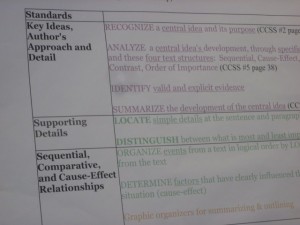What does College and Career Ready Really Mean?
While reading “The Early College Challenge” in the American Educator (Fall 2011) I was struck by the “what if” questions proposed by authors Rosenbaum and Becker. They suggest placing college course learning opportunities on the high school campus to ensure high school students are better prepared for college learning. However, these recommendations strike me as an avoidance of the many complex issues of public high school responsibilities.
This perplexing article asks: “What if, instead of hoping poorly prepared students will catch up in college, we supported them in taking rigorous courses – even college-level courses – before they graduate from high school?” The authors suggest:
- high schools use a “package-deal curriculum”.
- high schools keep students on track by closely monitoring student progress and giving them guidance.
- high schools explicitly teach study skills.
- high school teachers plan backwards from college so students become college ready.
The conundrum lies in the question: Aren’t high schools doing all this? And if not, is it funding issues that limit the public schools capabilities? Or is it influences entirely outside of school which limit student success?
As a parent of two college freshmen, one female and one male, (as well as being a high school English teacher/Reading specialist) I may have a unique voice on the issue. Were my children adequately prepared in high school for the college classroom? Will they be career ready? I say yes, though in ways that fit their unique capabilities.
Here’s a holistic look at their reading abilities: my son does not like to read, though he can read adequately he does not yet compare texts or discuss author’s voice and purpose at dinner-table discussions with ease or assurance – he scored a 21 on ACT Reading; my daughter loves to read – though a diagnosed dyslexic with an IEP in high school, she read every required text by following along with audio. She also read every book in the school library that was on audio tape, as well dozens more from the public library. She can compare texts and discuss author’s voice and purpose with ease and acuity at dinner-table discussions – she scored a 31 on ACT Reading. He passed the university’s English Competency exam, she did not. She fought the university on taking a 090 developmental course prior to English 101, and won. Her scores are higher in English 101 than his. (Note, however, that they have different instructors – both adjuncts.)
So what does it mean to be college ready? Passing scores on all assessments or just some? What assessments should be mandatory for college course enrollment? Who designs these assessments? Are they standard across universities? What skills do these assessments measure? How will K-12 know what universities know about the Common Core?
As a user of the SACI lesson plan method I now feel prepared to tell my students:
- here is a Common Core standard you will master by doing these lessons.
- here are the Common Core standards you must master in order to approach college coursework.
Did my son and daughter master each of the Common Core State Standards? I do not know as implementation is fledgling at best. And therein lies the dilemma. How will a high school diploma signify mastery of the standards?
As K-12 educators across the nation read, learn and write about addressing 21st century skills, we must determine how to join together with university professionals to share expectations and understandings of academic readiness and ensure that students receive assessments at standard exit and entrance points that are valid, reliable, and built on similar expectations linked to the CCSS. Let’s leave college courses to the university and focus on high school student’s mastery of high school skills and standards.
Finland, Rosenbaum and Becker write, with a population of 5.4 million living within 130 thousand square miles, prepares their homogeneous population well. Yes, we know. Our task as educators in this country is daunting; how can the heterogeneous United States, population 312 million living within 4 million square miles, do the same?
—
Follow us on Twitter @core4all
Questions or comments? Contact us at: core4all@gmail.com

March 6, 2012 at 9:44 am
I think it really boils down to a DI curriculum for almost every student. Maybe some high school students ARE ready for college level classes in HS. Others need more preparation before they head off to college and some won’t even go to college. Our school has about 2000 students – could we have 2000 different curricula?
March 10, 2012 at 12:44 pm
Interesting way to think about it – DI curriculum for 2000+ students. Imagine the work to keep tabs on every student when a typical high school teacher has 130 students per day. Perhaps we could send students ready for the university course to the university as we do with 7th and 8th graders coming over to the high school for advanced levels of math.
October 30, 2012 at 8:39 am
Dear Core4all,
I really enjoyed your article on the Common Core! It’s exciting to see how this is changing the way we teach and am so glad that the Common Core is being implemented in schools across the US.
We at TeacherStep, a company focused on making teacher recertification simple, offer professional development graduate courses for Teachers, created by Teachers!
We have just developed new CCSS education courses, and we would love to have you check them out. Here is our website: http://www.teacherstep.com.
Hope to hear back from you soon, our email address is below.
And thank you so much, your articles are wonderful!
Warmest Regards,
-The TeacherStep Team
courses@teacherstep.com